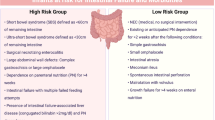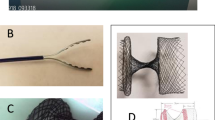Abstract
The advent of total parenteral nutrition in the late 1960s meant that no situation remained in which a patient could not be fed. Unfortunately, total parenteral nutrition was complicated by serious infective and metabolic side effects that undermined the beneficial effects of nutrient repletion. Consequently, creative ways of restoring upper gut function were designed, based on semielemental diets and novel feeding tube systems. The employment of specific protocols and acceptance of increased gastric residual volumes has allowed most patients in intensive care to be fed safely and early by nasogastric tube. However, nasogastric feeding is unsuitable for patients with severely compromised gastric emptying owing to partial obstruction or ileus. Such patients require postpyloric tube placement with simultaneous gastric decompression via double-lumen nasogastric decompression and jejunal feeding tubes. These tubes can be placed endoscopically 40–60 cm past the ligament of Treitz to enable feeding without pancreatic stimulation. In patients whose disorders last more than 4 weeks, tubes should be repositioned percutaneously, by endoscopic, open or laparoscopic surgery. Together, the advances in enteral access have improved patients' outcomes and led to a 70–90% reduction in the demand for total parenteral nutrition.
Key Points
-
Enteral feeding is more effective and is associated with fewer serious complications than total parenteral nutrition
-
Patients who would previously have been dependent on total parenteral nutrition can be fed enterally, which improves their outcomes
-
Patients with gastroesophageal reflux, subacute gastroduodenal obstruction, ileus, and diarrhea can be successfully fed by enteral access techniques
-
Patients who require enteral feeding for longer than 4 weeks should be considered for percutaneous feeding tube placement by endoscopy, radiology, laparoscopy or open surgery
This is a preview of subscription content, access via your institution
Access options
Subscribe to this journal
Receive 12 print issues and online access
$209.00 per year
only $17.42 per issue
Buy this article
- Purchase on Springer Link
- Instant access to full article PDF
Prices may be subject to local taxes which are calculated during checkout





Similar content being viewed by others
References
O'Keefe, S. J. D. et al. “Catabolic” loss of body nitrogen in response to surgery. Lancet 2, 1035–1038 (1974).
O'Keefe, S. J. D. et al. The influence of intravenous nutrition on protein dynamics following surgery. Metabolism 30, 1150–1158 (1981).
Mullady, D. K. & O'Keefe, S. J. Treatment of intestinal failure: home parenteral nutrition. Nat. Clin. Pract. Gastroenterol. Hepatol. 3, 492–504 (2006).
Sax, H. C. et al. Early total parenteral nutrition in acute pancreatitis: lack of beneficial effects. Am. J. Surg. 153, 117–124 (1987).
Marik, P. E. & Pinsky, M. Death by parenteral nutrition. Intensive Care. Med. 29, 867–869 (2003).
Fürst, P. Comment on “Death by parenteral nutrition” by Marik and Pinsky. Intensive Care. Med. 29, 2102–2104 (2003).
Varga, P. et al. Is parenteral nutrition guilty? Intensive Care. Med. 29, 1861–1864 (2003).
O'Keefe, S. J. D. et al. The physiological effects of enteral and parenteral feeding on pancreatobiliary secretion in humans. Am. J. Physiol. Gastrointest. Liver Physiol. 284, G27–G36 (2003).
Nguyen, N. Q. et al. Feed intolerance in critical illness is associated with increased basal and nutrient-stimulated plasma cholecystokinin concentrations. Crit. Care. Med. 35, 82–88 (2007).
O'Keefe, S. J. D. et al. Transnasal endoscopic placement of feeding tubes in the intensive care unit. JPEN J. Parenter. Enteral Nutr. 27, 349–354 (2003).
[No authors listed.] Guidelines for the use of parenteral and enteral nutrition in adult and pediatric patients. American Society for Parenteral and Enteral Nutrition. JPEN J. Parenter. Enteral Nutr. 17 (Suppl.), 1SA–52SA (1993).
Kudsk, K. A. et al. Enteral versus parenteral feeding. Effects on septic morbidity after blunt and penetrating abdominal trauma. Ann. Surg. 215, 503–511 (1992).
Moore, E. E. & Moore, F. A. Immediate enteral nutrition following multisystem trauma: a decade perspective. J. Am. Coll. Nutr. 10, 633–648 (1991).
Braunschweig, C. L. et al. Enteral compared with parenteral nutrition: a meta-analysis. Am. J. Clin. Nutr. 74, 534–542 (2001).
Petrov, M. S. et al. A randomized controlled trial of enteral versus parenteral feeding in patients with predicted severe acute pancreatitis shows a significant reduction in mortality and in infected pancreatic complications with total enteral nutrition. Dig. Surg. 23, 336–344 (2006).
O'Keefe, S. J. Total enteral nutrition or total parenteral nutrition for prophylaxis of infection in patients with severe acute pancreatitis. Nat. Clin. Pract. Gastroenterol. Hepatol. 4, 488–489 (2007).
O'Keefe, S. J. & Sharma, S. Nutrition support in severe acute pancreatitis. Gastroenterol. Clin. North Am. 36, 297–312 (2007).
Hegazi, R. A. & O'Keefe, S. J. Nutritional immunomodulation of acute pancreatitis. Curr. Gastroenterol. Rep. 9, 99–106 (2007).
Artinian, V. et al. Effects of early enteral feeding on the outcome of critically ill mechanically ventilated medical patients. Chest 129, 960–967 (2006).
Abou-Assi, S., Craig, K. & O'Keefe, S. J. D. Hypocaloric jejunal feeding is better than total parenteral nutrition in acute pancreatitis: results of a randomized comparative study. Am. J. Gastroenterol. 97, 2255–2262 (2003).
Esparza, J. et al. Equal aspiration rates in gastrically and transpylorically fed critically ill patients. Intensive Care. Med. 27, 660–664 (2001).
Heyland, D. K. et al. Effect of postpyloric feeding on gastroesophageal regurgitation and pulmonary microaspiration: results of a randomized controlled trial. Crit. Care. Med. 29, 1495–1501 (2001).
Montejo, J. C. et al. Multicenter, prospective, randomized, single-blind study comparing the efficacy and gastrointestinal complications of early jejunal feeding with early gastric feeding in critically ill patients. Crit. Care. Med. 30, 796–800 (2002).
Davies, A. R. et al. Randomized comparison of nasojejunal and nasogastric feeding in critically ill patients. Crit. Care. Med. 30, 586–590 (2002).
Eatock, F. C. et al. A randomized study of early nasogastric versus nasojejunal feeding in severe acute pancreatitis. Am. J. Gastroenterol. 100, 432–439 (2005).
Marik, P. E. & Zaloga, G. P. Early enteral nutrition in acutely ill patients: a systematic review. Crit. Care. Med. 29, 2264–2270 (2001).
Montejo, J. C. et al. Gastric residual volume during enteral nutrition in ICU patients. The REGANE study. Preliminary results [Abstract #0455]. Intensive Care Med. (2008).
McClave, S. A. et al. Guidelines for the provision and assessment of nutritional support therapy in the adult critically ill patient. SCCM and ASPEN. JPEN. J. Parenter. Enteral Nutr. (in press).
McClave, S. et al. Poor validity of residual volumes as a marker for risk of aspiration in critically ill patients. Crit. Care. Med. 33, 324–330 (2005).
Heyland, D. K. et al. Optimizing the benefits and minimizing the risks of enteral nutrition in the critically ill: role of small bowel feeding. JPEN J. Parenter. Enteral Nutr. 26 (Suppl.), S51–S57 (2002).
Kaushik, N. et al. Enteral feeding without pancreatic stimulation. Pancreas 31, 353–359 (2005).
White, A. R. (ed.) What's the best approach to early feeding in patients with acute pancreatitis. AGA Perspectives 2, 17–19 (2006).
Haslam, D. & Fang, J. Enteral access for nutrition in the intensive care unit. Curr. Opin. Clin. Nutr. Metab. Care 9, 155–159 (2006).
Zaloga, G. P. Bedside method for placing small bowel feeding tubes in critically ill patients. A prospective study. Chest 100, 1643–1646 (1991).
Lai, C. W., Barlow, R., Barnes, M. & Hawthorne, A. B. Bedside placement of nasojejunal tubes: a randomised-controlled trial of spiral vs straight-ended tubes. Clin. Nutr. 22, 267–270 (2003).
Young, R. J., Chapman, M. J., Fraser, R., Vozzo, R., Chorley, D. P. & Creed, S. A novel technique for post-pyloric feeding tube placement in critically ill patients: a pilot study. Anaesth. Intensive Care 33, 229–234 (2005).
Slagt, C., Innes, R., Bihari, D., Lawrence, J. & Shehabi, Y. A novel method for insertion of post-pyloric feeding tubes at the bedside without endoscopic or fluoroscopic assistance: a prospective study. Intensive Care. Med. 30, 103–107 (2004).
O'Keefe, S. J. D. et al. Transnasal endoscopic placement of feeding tubes in the intensive care unit. JPEN J. Parenter. Enteral Nutr. 27, 349–354 (2003).
DeLegge, M. H. et al. Ethical and medicolegal aspects of PEG-tube placement and provision of artificial nutritional therapy. Gastrointest. Endosc. 62, 952–959 (2005).
Sanders, D. S. et al. PEG placement in patients with dementia: a contentious ethical and clinical dilemma. Gastrointest. Endosc. 60, 492–493 (2004).
Shike, M. et al. Direct percutaneous endoscopic jejunostomies for enteral feeding. Gastrointest. Endosc. 44, 536–540 (1996).
McCarter, M. D. et al. Early postoperative enteral feeding following major upper gastrointestinal surgery. J. Gastrointest. Surg. 1, 278–285 (1997).
Barker, S. G. et al. Small bowel function after aortic surgery. Postgrad. Med. J. 67, 757–759 (1991).
Acknowledgements
I thank the NIH and NIDDK for their support through grants R01 DK56142 and R01 DK075803.Charles P Vega, University of California, Irvine, CA, is the author of and is solely responsible for the content of the learning objectives, questions and answers of the Medscape-accredited continuing medical education activity associated with this article.
Author information
Authors and Affiliations
Ethics declarations
Competing interests
The author declares no competing financial interests.
Rights and permissions
About this article
Cite this article
O'Keefe, S. A guide to enteral access procedures and enteral nutrition. Nat Rev Gastroenterol Hepatol 6, 207–215 (2009). https://doi.org/10.1038/nrgastro.2009.20
Issue Date:
DOI: https://doi.org/10.1038/nrgastro.2009.20
This article is cited by
-
Impact of Early Oral Feeding on Anastomotic Leakage Rate After Esophagectomy: A Systematic Review and Meta‐analysis
World Journal of Surgery (2020)
-
2019 update of the WSES guidelines for management of Clostridioides (Clostridium) difficile infection in surgical patients
World Journal of Emergency Surgery (2019)
-
WSES guidelines for management of Clostridium difficile infection in surgical patients
World Journal of Emergency Surgery (2015)
-
Endoscopic Clip-Assisted Feeding Tube Placement Reduces Repeat Endoscopy Rate: Results from a Randomized Controlled Trial
American Journal of Gastroenterology (2012)



